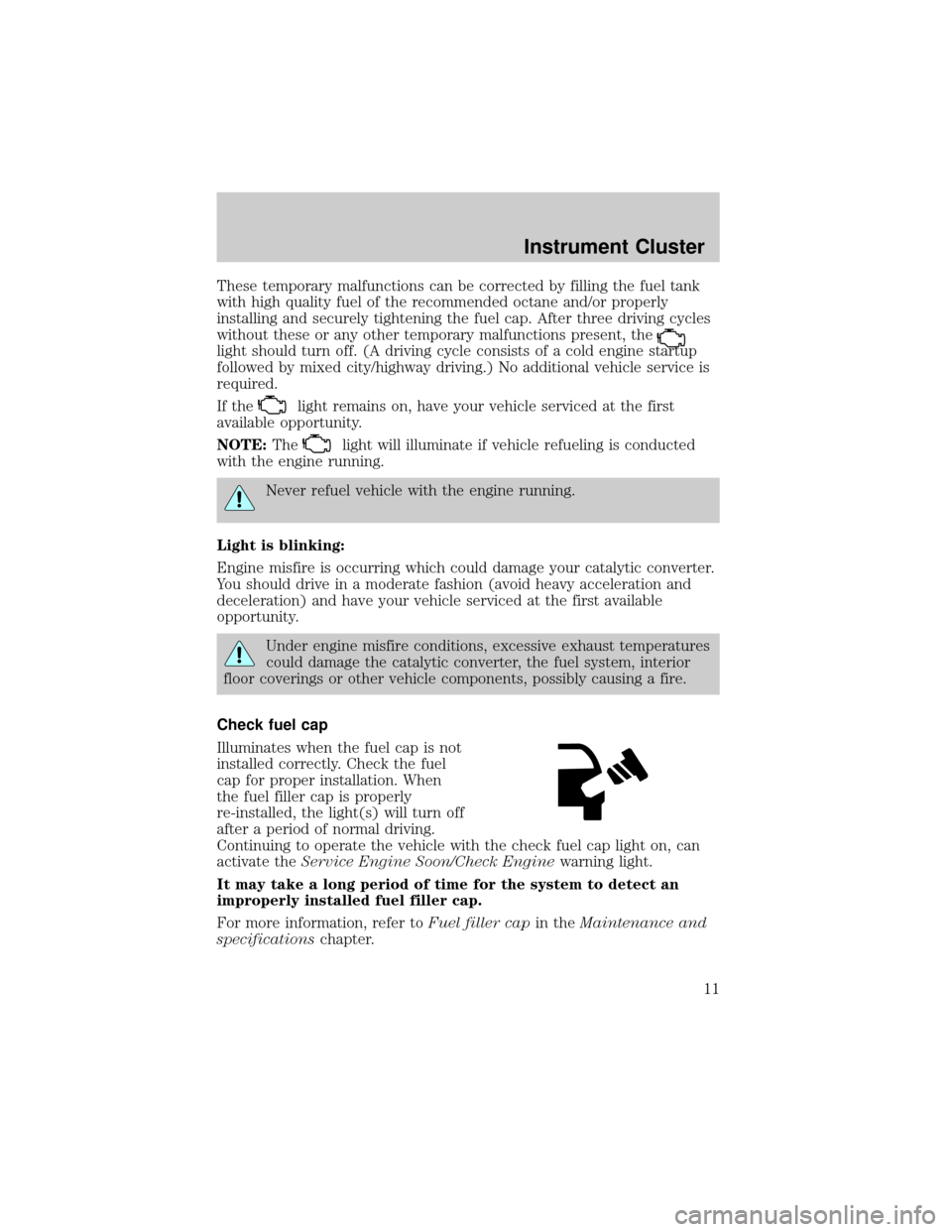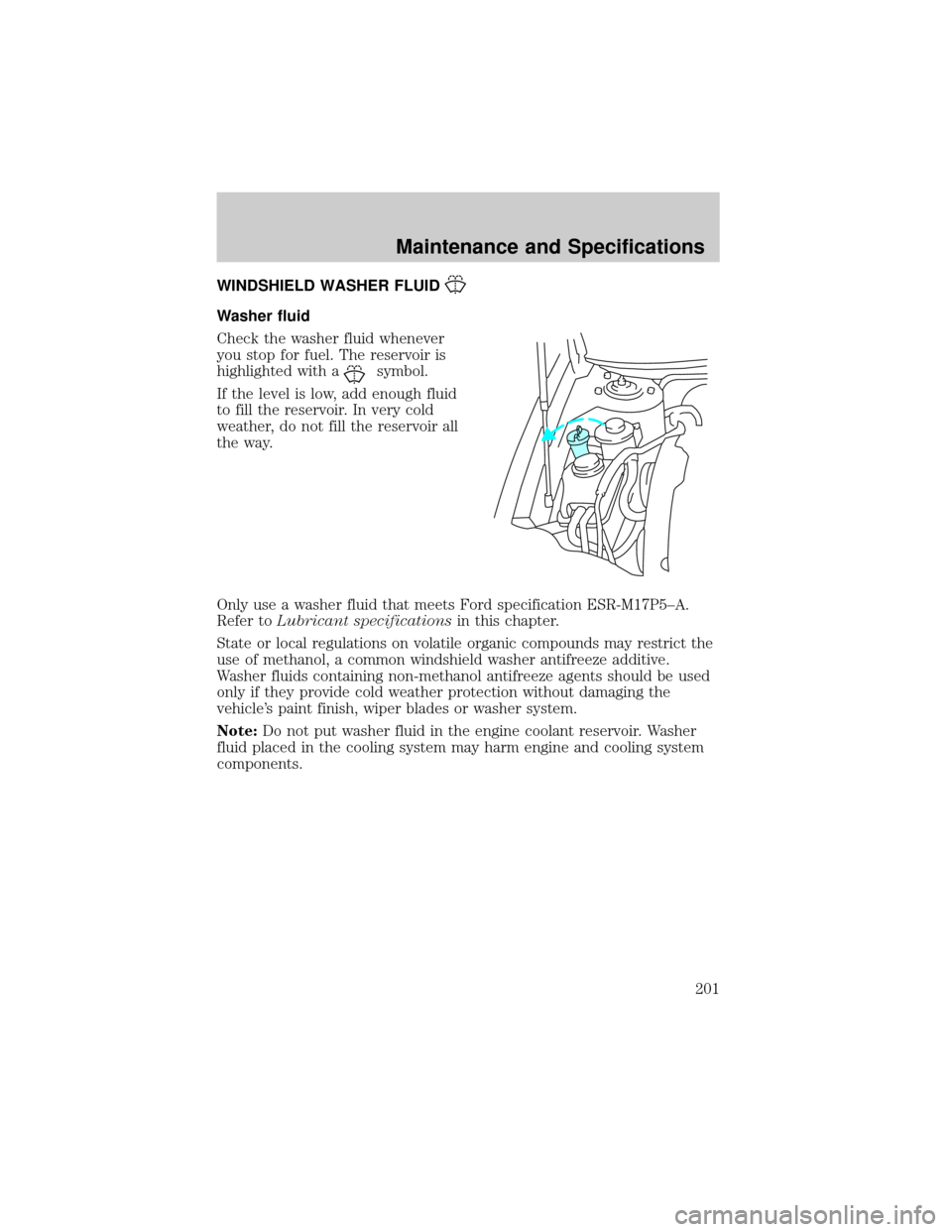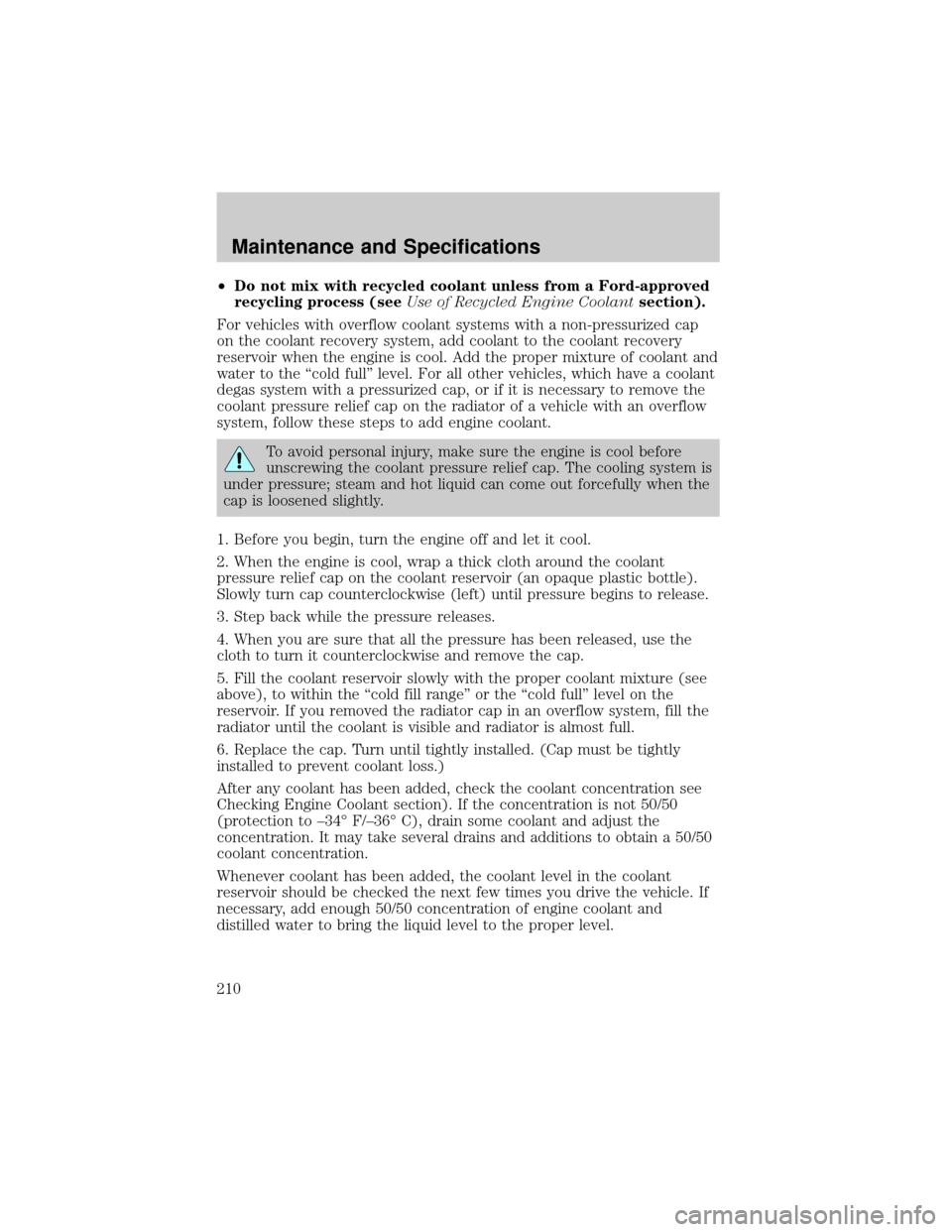check engine light FORD TAURUS 2002 4.G Owners Manual
[x] Cancel search | Manufacturer: FORD, Model Year: 2002, Model line: TAURUS, Model: FORD TAURUS 2002 4.GPages: 248, PDF Size: 2.12 MB
Page 11 of 248

These temporary malfunctions can be corrected by filling the fuel tank
with high quality fuel of the recommended octane and/or properly
installing and securely tightening the fuel cap. After three driving cycles
without these or any other temporary malfunctions present, the
light should turn off. (A driving cycle consists of a cold engine startup
followed by mixed city/highway driving.) No additional vehicle service is
required.
If the
light remains on, have your vehicle serviced at the first
available opportunity.
NOTE:The
light will illuminate if vehicle refueling is conducted
with the engine running.
Never refuel vehicle with the engine running.
Light is blinking:
Engine misfire is occurring which could damage your catalytic converter.
You should drive in a moderate fashion (avoid heavy acceleration and
deceleration) and have your vehicle serviced at the first available
opportunity.
Under engine misfire conditions, excessive exhaust temperatures
could damage the catalytic converter, the fuel system, interior
floor coverings or other vehicle components, possibly causing a fire.
Check fuel cap
Illuminates when the fuel cap is not
installed correctly. Check the fuel
cap for proper installation. When
the fuel filler cap is properly
re-installed, the light(s) will turn off
after a period of normal driving.
Continuing to operate the vehicle with the check fuel cap light on, can
activate theService Engine Soon/Check Enginewarning light.
It may take a long period of time for the system to detect an
improperly installed fuel filler cap.
For more information, refer toFuel filler capin theMaintenance and
specificationschapter.
Instrument Cluster
11
Page 197 of 248

SERVICE RECOMMENDATIONS
To help you service your vehicle:
²We highlight do-it-yourself items in the engine compartment for easy
location.
²We provide a scheduled maintenance guide which makes tracking
routine service easy.
If your vehicle requires professional service, your dealership can provide
the necessary parts and service. Check yourWarranty Guideto find out
which parts and services are covered.
Use only recommended fuels, lubricants, fluids and service parts
conforming to specifications. Motorcraft parts are designed and built to
provide the best performance in your vehicle.
PRECAUTIONS WHEN SERVICING YOUR VEHICLE
Be especially careful when inspecting or servicing your vehicle.
²Do not work on a hot engine.
²When the engine is running, keep loose clothing, jewelry or long hair
away from moving parts.
²Do not work on a vehicle with the engine running in an enclosed
space, unless you are sure you have enough ventilation.
²Keep all lit cigarettes, open flames and other lit material away from
the battery and all fuel related parts.
If you disconnect the battery, the engine must ªrelearnº its idle
conditions before your vehicle will drive properly, as explained in the
Batterysection in this chapter.
Working with the engine off
1. Set the parking brake, and ensure the gearshift is securely latched in
(P) park.
2. Turn off the engine and remove the key.
3. Block the wheels to prevent the vehicle from moving unexpectedly.
Maintenance and Specifications
197
Page 201 of 248

WINDSHIELD WASHER FLUID
Washer fluid
Check the washer fluid whenever
you stop for fuel. The reservoir is
highlighted with a
symbol.
If the level is low, add enough fluid
to fill the reservoir. In very cold
weather, do not fill the reservoir all
the way.
Only use a washer fluid that meets Ford specification ESR-M17P5±A.
Refer toLubricant specificationsin this chapter.
State or local regulations on volatile organic compounds may restrict the
use of methanol, a common windshield washer antifreeze additive.
Washer fluids containing non-methanol antifreeze agents should be used
only if they provide cold weather protection without damaging the
vehicle's paint finish, wiper blades or washer system.
Note:Do not put washer fluid in the engine coolant reservoir. Washer
fluid placed in the cooling system may harm engine and cooling system
components.
Maintenance and Specifications
201
Page 210 of 248

²Do not mix with recycled coolant unless from a Ford-approved
recycling process (seeUse of Recycled Engine Coolantsection).
For vehicles with overflow coolant systems with a non-pressurized cap
on the coolant recovery system, add coolant to the coolant recovery
reservoir when the engine is cool. Add the proper mixture of coolant and
water to the ªcold fullº level. For all other vehicles, which have a coolant
degas system with a pressurized cap, or if it is necessary to remove the
coolant pressure relief cap on the radiator of a vehicle with an overflow
system, follow these steps to add engine coolant.
To avoid personal injury, make sure the engine is cool before
unscrewing the coolant pressure relief cap. The cooling system is
under pressure; steam and hot liquid can come out forcefully when the
cap is loosened slightly.
1. Before you begin, turn the engine off and let it cool.
2. When the engine is cool, wrap a thick cloth around the coolant
pressure relief cap on the coolant reservoir (an opaque plastic bottle).
Slowly turn cap counterclockwise (left) until pressure begins to release.
3. Step back while the pressure releases.
4. When you are sure that all the pressure has been released, use the
cloth to turn it counterclockwise and remove the cap.
5. Fill the coolant reservoir slowly with the proper coolant mixture (see
above), to within the ªcold fill rangeº or the ªcold fullº level on the
reservoir. If you removed the radiator cap in an overflow system, fill the
radiator until the coolant is visible and radiator is almost full.
6. Replace the cap. Turn until tightly installed. (Cap must be tightly
installed to prevent coolant loss.)
After any coolant has been added, check the coolant concentration see
Checking Engine Coolant section). If the concentration is not 50/50
(protection to ±34É F/±36É C), drain some coolant and adjust the
concentration. It may take several drains and additions to obtain a 50/50
coolant concentration.
Whenever coolant has been added, the coolant level in the coolant
reservoir should be checked the next few times you drive the vehicle. If
necessary, add enough 50/50 concentration of engine coolant and
distilled water to bring the liquid level to the proper level.
Maintenance and Specifications
210
Page 221 of 248
![FORD TAURUS 2002 4.G Owners Manual ²Slow down gradually.
²Driving at reasonable speeds (traveling at 88 km/h [55 mph] uses 15%
less fuel than traveling at 105 km/h [65 mph]).
²Revving the engine before turning it off may reduce fuel FORD TAURUS 2002 4.G Owners Manual ²Slow down gradually.
²Driving at reasonable speeds (traveling at 88 km/h [55 mph] uses 15%
less fuel than traveling at 105 km/h [65 mph]).
²Revving the engine before turning it off may reduce fuel](/img/11/5374/w960_5374-220.png)
²Slow down gradually.
²Driving at reasonable speeds (traveling at 88 km/h [55 mph] uses 15%
less fuel than traveling at 105 km/h [65 mph]).
²Revving the engine before turning it off may reduce fuel economy.
²Using the air conditioner or defroster may reduce fuel economy.
²You may want to turn off the speed control in hilly terrain if
unnecessary shifting between third and fourth gear occurs.
Unnecessary shifting of this type could result in reduced fuel
economy.
²Warming up a vehicle on cold mornings is not required and may
reduce fuel economy.
²Resting your foot on the brake pedal while driving may reduce fuel
economy.
²Combine errands and minimize stop-and-go driving.
Maintenance
²Keep tires properly inflated and use only recommended size.
²Operating a vehicle with the wheels out of alignment will reduce fuel
economy.
²Use recommended engine oil. Refer toLubricant specificationsin
this chapter.
²Perform all regularly scheduled maintenance items. Follow the
recommended maintenance schedule and owner maintenance checks
found in your vehicle scheduled maintenance guide.
Conditions
²Heavily loading a vehicle or towing a trailer may reduce fuel economy
at any speed.
²Carrying unnecessary weight may reduce fuel economy (approximately
0.4 km/L [1 mpg] is lost for every 180 kg [400 lb] of weight carried).
²Adding certain accessories to your vehicle (for example bug
deflectors, rollbars/light bars, running boards, ski/luggage racks) may
reduce fuel economy.
²Using fuel blended with alcohol may lower fuel economy.
²Fuel economy may decrease with lower temperatures during the first
12±16 km (8±10 miles) of driving.
Maintenance and Specifications
221
Page 243 of 248

A
Accessory delay ..........................70
Air bag supplemental
restraint system ........121±122, 126
and child safety seats ............124
description ......................122, 126
disposal ....................................128
driver air bag ..........121, 125, 127
indicator light ...................12, 125
operation .................121, 125, 127
passenger air bag ...121, 125, 127
side air bag ..............................126
Air cleaner filter .......................232
Air conditioning ..........................43
manual heating and air
conditioning system .................40
Air filter, cabin ............................50
Antifreeze
(see Engine coolant) ................207
Anti-lock brake system
(see Brakes) ......................143±144
Anti-theft system ........................98
arming the system ....................98
disarming a triggered
system .......................................99
warning light .............................14
Automatic transaxle .................148
driving with .............................150
fluid, adding ............................226
fluid, checking ........................226
fluid, refill capacities ..............233
fluid, specification ..................236
Auxiliary power point .................69
Axle
lubricant specifications ..........234B
Battery .......................................205
acid, treating emergencies .....205
charging system
warning light .............................12
jumping a disabled battery ....172
maintenance-free ....................205
replacement,
specifications ..........................232
servicing ..................................205
Belt minder ...............................116
Brakes ........................................143
anti-lock ...........................143±144
anti-lock brake system
(ABS) warning light .........12, 144
brake warning light ..................12
fluid, checking and adding ....225
fluid, refill capacities ..............233
fluid, specifications .........234, 236
lubricant
specifications ..................234, 236
parking ....................................145
pedals (see Power
adjustable foot pedals) ............74
shift interlock ..........................148
Break-in period .............................6
C
Capacities for refilling fluids ....233
Cargo area shade ........................83
Cargo cover .................................82
Cargo net ...............................81±82
CD changer .................................35
Cellular telephone (see your
Cellular Phone Guide) ................79
Certification Label ....................238
Index
243
Page 244 of 248

Child safety restraints ..............129
child safety belts ....................129
Child safety seats ......................130
attaching with tether straps ..134
in front seat ............................131
in rear seat ......................131, 134
Cleaning your vehicle
engine compartment ..............191
exterior ....................................195
instrument cluster lens ..........193
instrument panel ....................193
interior .....................................194
plastic parts ............................192
safety belts ..............................195
washing ....................................189
waxing .....................................189
wheels ......................................190
windows ..................................195
wiper blades ............................193
woodtone trim ........................195
Clock ................................22, 27, 33
Compass, electronic ....................71
calibration .................................73
set zone adjustment .................72
Console ........................................78
Controls
power seat ...............................103
Coolant
checking and adding ..............207
refill capacities ................211, 233
specifications ..................234, 236
Cruise control
(see Speed control) ....................75
Customer Assistance ................159
Ford accessories for
your vehicle ............................195
Ford Extended
Service Plan ............................181Getting assistance outside
the U.S. and Canada ..............185
Getting roadside assistance ...159
Getting the service
you need .................................179
Ordering additional
owner's literature ...................186
The Dispute Settlement
Board .......................................182
Utilizing the Mediation/
Arbitration Program ...............185
D
Daytime running lamps
(see Lamps) ................................51
Defrost
rear window ..............................50
Dipstick
automatic transmission
fluid ..........................................226
engine oil .................................202
Doors
door ajar warning .....................14
lubricant specifications ..........234
Driving under special
conditions
through water .........................153
E
Emergencies, roadside
jump-starting ..........................172
Emission control system ..........222
Engine ........................................236
check engine/service
engine soon light ......................10
cleaning ...................................191
coolant .....................................207
Index
244
Page 245 of 248

idle speed control ...................205
lubrication
specifications ..................234, 236
refill capacities ........................233
service points ..................199±200
starting after a collision .........160
Engine block heater .................142
Engine oil ..................................202
checking and adding ..............202
dipstick ....................................202
filter, specifications ........204, 232
recommendations ...................204
refill capacities ........................233
specifications ..................234, 236
Exhaust fumes ..........................142
F
Flexible Fuel Vehicle (FFV) ....212
Floor mats ...................................80
Fluid capacities .........................233
Fuel ............................................212
calculating fuel economy .......219
cap .....................................11, 215
capacity ...................................233
choosing the right fuel ...........216
comparisons with EPA fuel
economy estimates .................222
detergent in fuel .....................218
filling your vehicle
with fuel ..................212, 215, 219
filter, specifications ........218, 232
fuel pump shut-off switch .....160
gauge .........................................17
improving fuel economy ........219
low fuel warning light ..............13
octane rating ...................216, 236
quality ......................................217
running out of fuel .................218safety information relating
to automotive fuels ................212
Fuses ..................................162±163
G
Gas cap (see Fuel cap) ......11, 215
Gas mileage
(see Fuel economy) .................219
Gauges .........................................16
engine coolant
temperature gauge ...................16
fuel gauge ..................................17
odometer ...................................17
speedometer .............................17
tachometer ................................18
trip odometer ............................18
GAWR (Gross Axle
Weight Rating) ..........................153
definition .................................153
driving with a heavy load ......153
location ....................................153
GVWR (Gross Vehicle
Weight Rating) ..........................153
calculating ...............................153
definition .................................153
driving with a heavy load ......153
location ....................................153
H
Hazard flashers .........................160
Head restraints .........................101
Headlamps ...................................51
aiming ..................................52±53
autolamp system .......................51
bulb specifications ....................56
daytime running lights .............51
flash to pass ..............................52
Index
245
Page 246 of 248

high beam ...........................14, 52
replacing bulbs .........................58
turning on and off ....................51
warning chime ..........................15
Heating ........................................43
heating and air conditioning
system .......................................40
Hood ..........................................198
I
Ignition ...............................138, 236
Infant seats
(see Safety seats) .....................130
Inspection/maintenance
(I/M) testing ..............................223
Instrument panel
cleaning ...................................193
cluster ................................10, 193
lighting up panel
and interior ...............................52
J
Jack ............................................168
positioning ...............................168
storage .....................................168
Jump-starting your vehicle ......172
K
Keyless entry system .................91
autolock .....................................94
keypad .......................................91
locking and unlocking doors ....93
programming entry code .........92
Keys .................................94±95, 97
key in ignition chime ...............15
positions of the ignition .........138L
Lamps
autolamp system .......................51
bulb replacement
specifications chart ..................56
cargo lamps ...............................52
daytime running light ...............51
headlamps .................................51
headlamps, flash to pass ..........52
instrument panel, dimming .....52
interior lamps .....................54, 56
replacing
bulbs ..................56, 58, 60±62, 64
Lane change indicator
(see Turn signal) ........................54
Liftgate ..................................81, 88
Lights, warning and indicator ....10
air bag ........................................12
anti-lock brakes (ABS) ....12, 144
anti-theft ...................................14
brake ..........................................12
charging system ........................12
check coolant ............................14
cruise indicator .........................13
door ajar ....................................14
fuel cap light .............................11
high beam .................................14
low coolant ................................13
low fuel ......................................13
oil pressure ...............................13
safety belt .................................12
service engine soon ..................10
speed control ............................78
traction control active ..............13
turn signal indicator .................14
Load limits .................................153
GAWR ......................................153
GVWR ......................................153
trailer towing ..........................153
Index
246
Page 247 of 248

Locks
autolock .....................................94
childproof ..................................85
doors ..........................................85
Lubricant
specifications .....................234, 236
Lumbar support, seats .............101
M
Mirrors .........................................68
automatic dimming
rearview mirror .........................71
heated ........................................74
side view mirrors (power) .......73
Moon roof ....................................78
Motorcraft parts ................218, 232
O
Octane rating ............................216
Odometer .....................................17
Oil (see Engine oil) ..................202
Overdrive ...................................149
P
Panic alarm feature, remote
entry system ................................88
Parking brake ............................145
Parts (see Motorcraft parts) ....232
Pedals (see Power
adjustable foot pedals) ...............74
Power distribution box
(see Fuses) ...............................166
Power door locks ........................85
Power steering ..........................147fluid, checking and adding ....224
fluid, refill capacity ................233
fluid, specifications .........234, 236
R
Rear window defroster ...............50
Relays ................................162, 168
Remote entry system ...........87±88
illuminated entry ................90±91
locking/unlocking doors ..........85,
87±88
opening the trunk .....................88
panic alarm ...............................88
replacement/additional
transmitters ...............................89
replacing the batteries .............89
Roof rack .....................................84
S
Safety belts (see Safety
restraints) ....15, 105, 108±111, 113
Safety defects, reporting ..........188
Safety restraints ........105, 108±114
belt minder .............................116
cleaning the safety
belts .................................120, 195
extension assembly ................120
for adults .........................109±111
for children .....................128±129
lap belt ....................................113
warning light
and chime ......12, 14±15, 115±116
Safety seats for children ..........130
Seat belts
(see Safety restraints) .............105
Seats ..........................................101
child safety seats ....................130
cleaning ...................................194
Index
247